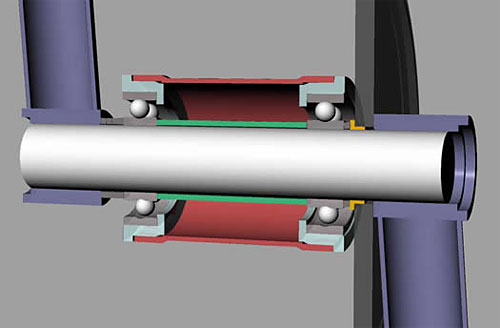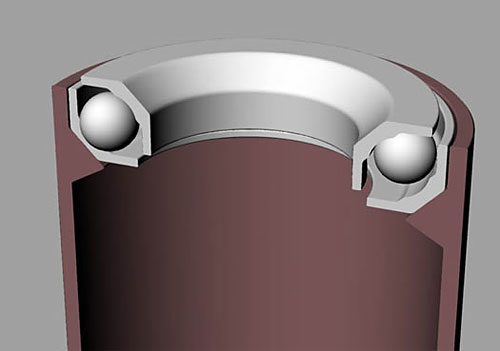Wobble is play or movent in a bearing system. Cranks and hubs will experience it as latteral (axial; side to side) play, while headsets most often exhibit radial play. Although there is a difference in the tensioning mechanism of the two systems, some of the reason the play is different is due simply to the way we test for play: sitting attop our bikes shaking things around.
What causes wobble?
Even though the three bearing systems in our bikes (hubs, headset, and bottom bracket) are slightly different from one another, they all operate on the same principals. Essentially a bearing is placed at the interface of two tubes (headtube/steerer; spindle/BB shell; axle/hub shell) in order to minimize friction between the surfaces. In conventional threaded, poorly sealed systems, the ball bearings are held in place by positioning the inner race against the balls just enough to hold everything steady, but not so much as to add resistance to the system. This direct adjustment system is very simple and easy to understand; BUT it is finicky, and annoying to deal with under a time constraint.
We have moved, almost entirely, to sealed, cartridge bearing systems. These are bearings in which the inner and outer races entrap the balls or rollers in one assembly. These cartridges are easily installed and removed (except when the bearing shatters and the outer race gets stuck), have virtually zero maintenance, and reduce working time. In cartridge bearing systems, the inner race of the cartridge is fixed on both sides, while the outer race is only fixed at inside.
Image from George French's Ride UK article Three Piece Crank Assembly

There are a few main causes of "wobble" in a bearing system:
- Poor inner race tension. This is the most common cause of wobble. On a normal, one piece axle system (conventional thread-on cone nuts), this can be the result of stripped threads, no spacer between driver and hubshell bearings, or poor bearing shoulders causing the cone nuts to run out of threads. On "sliding hardware" hubs, headsets, and crank sets, the tensioning bits (collars, spacers, stem, arm, etc) need to transfer force from the tensioning bolts while allowing the axle to slide beneath. What that means is that you need to add spacers so that the axle/steerer/spindle does not bottom out on the dropout/topcap/crank bolt. As you can see in the below photo, G-sport hubs require the collars to stick out farther than the inner axle (just as the crank arm and stem must be higher than the spindle and steerer). This is true of all female axle hubs that do not sit in the dropouts.

- Poor bearing seats can also be a cause of wobble. Many people are familiar with ovalized headtubes, but the same thing can happen with bottom brackets and hubshells, usually from poor manufacturing. If the outer race is not secured properly, wobble will be virtually impossible to remove. To reduce a knocking sound, you can add grease or a retaining compound to the bearing seat; But a perminent solution is to change frames or hubs.
- Poor interface between crank arm and spindle can lead to axial and/or rotational play. This only really happens on cranks because they are the only interface where rotational loads are constantly supported. Here is an article about interface wobble in 48-spline cranks, specifically Profile Racing cranks.
- Blown bearings aren't as common as they used to be, but some times it happens. Try not to install or remove bearings by their inner races, as that puts axial load on conventional bearings that are not intended to handle such loads. The obvious exception is when dealing with angular contact bearings (such as most integrated headsets):

Conclusion
So the next time you find some play in your ride, before cursing some company with "******* Wobble", think about what could be causing the wobble. Maybe just adding some shims, or cutting a small bit off the axle or steerer is an easy solution.
No comments:
Post a Comment